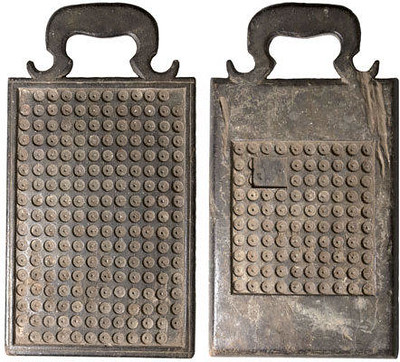
PREV ARTICLE
NEXT ARTICLE
FULL ISSUE
PREV FULL ISSUE
VOCABULARY TERM: COIN COUNTERDick Johnson submitted this entry from his Encyclopedia of Coin and Medal Terminology. Thanks. I added an image from a 2015 Stephen Album Rare Coins auction of a rare two-side coin board - one side holds 100 coins, the other 200. -Editor Coin Counter. A device or machine to determine the precise number of coins. Once the production of coins increased to large numbers in mints after the industrial revolution, manual counting of coins could not keep up with the capacity of the coining presses. Counting board. The first device used, both in England, America and elsewhere, was the counting board. Devised in the early 19th century it was used into the 20th century. The first models had the required number of circular depressions in a flat board – slightly larger than the diameter of the coins being counted – but of equal depth as the coin was thick. The coins would easily fall into these openings, but a second one would not. The mint required a different board for each denomination. Coins were dumped on these and spread around by hand until they filled every depression. Excess coins were returned to the hopper from which they came. 
wooden chuckram counting board, 19th century Later models had channels built into the board the width of the coin. Even later ones had brass rails the thickness of the coin to create these channels. The board was supported on the underside in the center by a horizontal axle, much like a teeter totter. Coins would be spread over the channels on the top side, then tilted toward one worker to allow excess coins to fall back into the hopper. After visual inspection that all channels were full they would tip the board in the opposite direction for the coins to fall out of the channels. The coins would then be funneled into cloth bags. Amazingly, one report states 400 coins could be counted in 12 seconds with two men, one dumping and spreading the coins, one pouring counted coins into a bag and tying it off. Counting machines. When even this proved inadequate to keep with the outpouring from the presses, the manufacturers of rolling mills turned also to creating machines for counting coins. The first coin counter – the British called them automatic telling machines – were developed by Maudslay, Sons, and Field, and installed in 1891 at the British Royal Mint. Technology further increased the usefulness of these machines, which could be used with wrapper rolling mechanisms to automatically count and roll coins to a prescribed number. This was ideal for use in bank's counting rooms, more so than in mints, which preferred to continue bagging coins in cloth sacks in large quantities.
References: Looking for the meaning of a numismatic word, or the description of a term? Try the Newman Numismatic Portal's Numismatic Dictionary at: https://nnp.wustl.edu/library/dictionary
Or if you would like a printed copy of the complete Encyclopedia, it is available.
There are 1,854 terms, on 678 pages, in The Encyclopedia of Coin and Medal Technology. Even running two a week would require more than 19 years to publish them all.
If you would like an advance draft of this vital reference work it may be obtained from the author for your check of $50 sent postpaid. Dick Johnson, 139 Thompson Drive, Torrington, CT 06790.
The Numismatic Bibliomania Society is a non-profit organization promoting numismatic literature. See our web site at coinbooks.org. To submit items for publication in The E-Sylum, write to the Editor at this address: whomren@gmail.com To subscribe go to: https://my.binhost.com/lists/listinfo/esylum All Rights Reserved. NBS Home Page Contact the NBS webmaster 
|